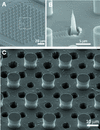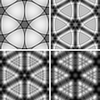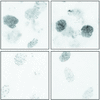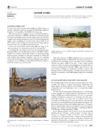issue contents
July 2014 issue

Cover illustration: Intensity distributions of a synchrotron X-ray beam modulated by a Ni inverted photonic crystal with the [111] axis of the face-centred-cubic structure at distances of 0, 8, 16 and 24 µm (left to right, top to bottom) from the crystal (see Kohn, Snigireva and Snigirev, pages 729-735). The crystal has nine layers, and it changes only the phase of the X-ray wave. However, with increasing distance the intensity distribution becomes more pronounced.
facility information
feature articles
Open  access
access
 access
accessA comprehensive review about the use of micro- and nanostructured superhydrophobic surfaces as a tool for in situ X-ray scattering investigations of soft matter and biological materials.
research papers
Using the infrared free-electron laser system of the storage ring NIJI-IV, some unique characteristics of the higher harmonics emitted from an optical klystron have been clarified.
Fixed-geometry elliptical Kirkpatrick–Baez mirrors for micro-focusing of hard X-rays are pre-qualified at the optics and detector testing beamline of the Advanced Photon Source and then installed at an Advanced Photon Source micro-probe beamline for user science.
Open  access
access
 access
accessA new 'Hybrid Method' combining ray-tracing and wavefront propagation for X-ray optics simulation is reported. The code is fast and can handle partially coherent sources, making it a useful tool for beamline design and optimization.
Open  access
access
 access
accessThe design, performance and first results of the new macromolecular crystallography beamline BL13-XALOC at the ALBA Synchrotron are described, including new developments in optics and control.
Radiolytic labeling is established as a collaborative program at the Advanced Light Source (ALS). Results indicate that white-light bend-magnet beamlines at the ALS produce flux densities high enough to allow microsecond exposures yielding sufficient modification to conduct footprinting experiments, representing a significant advance for the footprinting experiment.
On the basis of the eikonal approximation, X-ray Bragg-case focusing by a perfect crystal with parabolic-shaped entrance surface is investigated theoretically.
Open  access
access
 access
accessThe technical realisation as well as the first commissioning experiments of a high-speed X-ray detection scheme based on a quadrant avalanche silicon photodiode for single-pulse multiphoton detection of synchrotron radiation are described. It is shown that the detector is able to record the exact number of photons for each pulse continuously at a repetition rate of ≥31 MHz.
An array of filtered detectors capable of energy discrimination is proposed. The feasibility of measuring partial fluorescence spectra with filtered total fluorescence yield detectors is verified using a two-detector array comparing the resultant spectra with those measured with a solid-state detector.
Spatial coherence measurements of synchrotron radiation were performed with non-redundant arrays of apertures at the XUV beamline at the PETRA III storage ring. This approach allows to fully characterize spatial coherence of the beam from a single diffraction pattern.
The intensity distributions of an X-ray beam modified by a photonic crystal are calculated. A method of computing is developed, and the evolution of an image with increasing distance from the crystal is investigated. The image changes significantly over a distance of several micrometres.
This paper presents the design of a RIXS spectrometer for simultaneous measurement of incoming and outgoing photon energy at high resolution over the bandwidth of an elemental absorption resonance.
An energy-resolving electron-yield detector is used for depth-sensitive in situ XAS experiments on catalytically relevant aluminophsophates.
The colouration mechanism of the red and orange areas of underglaze copper-red decoration porcelain has been investigated.
A new data analysis method allowing sub-10 pm spatial resolution to be obtained using EXAFS is presented. The method was tested using theoretical simulation and experimental data. A resolution better than 0.074 Å is achieved using 12 Å−1 data which has a resolution limit of 0.13 Å for the existing EXAFS data analysis methods.
Open  access
access
 access
accessA new measurement technique for X-ray spectrometers equipped with a position-sensitive detector is introduced. It is based on the computational compensation of the effects of internal stress of curved analyser crystals to improve the energy resolution in the measurements of point-like samples with no loss of intensity.
Synchrotron phase-contrast X-ray imaging is well suited to non-invasive live imaging in small-animal models such as mice. However, due to the radiation dose delivered, the use of longitudinal studies has not previously been reported. In this report the post-deposition mucociliary transit behaviour of deposited particulates in the trachea of live mice is examined using a longitudinal study design incorporating repeat imaging at periods of 3, 9 or 25 h.
The retrieval of spatially resolved atomic displacements is investigated via the phases of the direct(real)-space image reconstructed from the strained crystal's coherent X-ray diffraction pattern.
Open  access
access
 access
accessQuantitative analysis concerning the application of a single-distance phase-retrieval algorithm on in-line phase-contrast images of a mouse lung at different sample-to-detector distances is presented.
A Zernike X-ray full-field microscope has been set up and applied to imaging of biological samples.
To obtain higher image contrast in phase-contrast X-ray computed tomography, the fixation technique has been examined with 100% ethanol and the commonly used 10% formalin. Fine renal structure was depicted by the ethanol fixation, and the image was approximately three times higher in contrast in all renal areas due to the physical properties and strong dehydration by ethanol.
Immunofluorescence microscopy is used to investigate DNA damage formation, DNA repair and apoptosis in cultured normal human fibroblasts and human malignant glioma cells exposed to synchrotron-generated microbeams.
short communications
The concept of a concave aluminium wedge-shaped absorber for hard X-ray synchrotron beamlines is presented. Unlike commonly used absorber types, this concept allows a compact system, controlled with a single linear positioner, and provides a wide attenuation range as well as a precise tunability over a large energy range.
Open  access
access
 access
accessFirst real-time studies of ultra-fast processes by means of a single-bunch imaging technique at the European Synchrotron Radiation Facility are reported. Both absorption contrast and phase contrast are accessible thanks to propagation distances of several metres.
beamlines
The layout and the characteristics of the hard X-ray beamline BL10 at the superconducting asymmetric wiggler at the 1.5 GeV Dortmund Electron Accelerator DELTA are described.
An introduction to the X-ray microscopy and tomography beamline 7C at Pohang Light Source II.
letters to the editor
Free 

Comments on Ramesh et al. [J. Synchrotron Rad. (2013). 20, 843–847].
Free 

Response to Merlino et al.'s comments in the previous paper.
current events
Free 



 journal menu
journal menu





















































